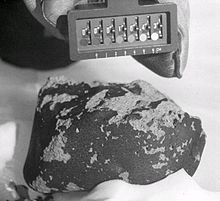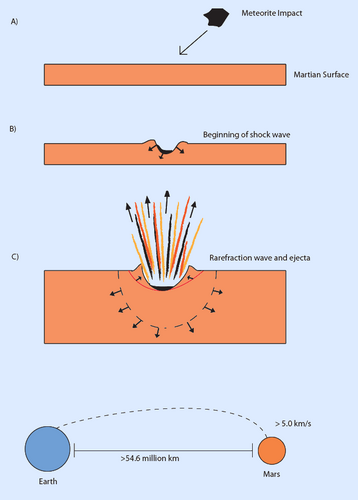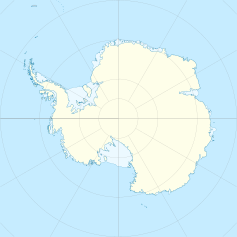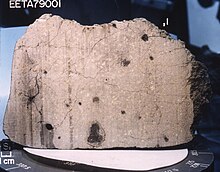270:
planets was at first not popular with scientists, as they believed such an impact would completely melt the ejected debris, EETA 79001 showed that while some portion is likely melted from impact, original rock crystals can survive the process. This meteorite is one of only 99 known meteorites discovered on Earth, of
Martian origin. Martian meteorites were critical in our early understanding of a planet that is both a close neighbor and physically very similar to Earth. Before lander missions, the only physical samples to be analyzed were meteorites ejected from Mars, and impacting on Earth.
69:
109:
53:
149:
116:
61:
269:
EETA 79001 has been shown to originate from the
Martian interior, so holds great importance because of the clues it can provide about the composition and evolution of Mars. It was the first sample that provided conclusive evidence of an origin from Mars. The idea of meteorites ejected from other
201:
The meteorite is a nearly completely crystalline rock, with a composition typical of volcanic lava crystallized from molten silicate. The sample closely resembles that of basalts collected from Earth and the Moon. Close examination of this sample shows glassy feldspar, which can be shown to have
197:
The meteorite is made up of two distinct lithologies, designated as lithology A and lithology B. Lithology B is an igneous melt, almost certainly originating deep in the
Martian crust. Lithology A has some uncertainty associated with it, but appears to be made up of shocked, impact melt from the
72:
Impact and ejection sequence of a
Martian meteorite. At time A, the impact of meteorite in imminent. At time B, the meteorite has impacted, melting and introducing a large amount of energy into the surface. This surface energy propagates as a shock wave. At time C, the shock wave continues to
77:
pushes back towards the crater in response, and material is ejected from the crater. If any of this material is moving at a rate faster than the escape velocity (5.0 km/s) of Mars, it may leave the influence of
Martian gravity. Mars has a minimum distance from Earth of 54.6 million km that the
166:
compositions. These same compositions were measured in the
Martian atmosphere by the Viking spacecraft in 1976. This match was some of the first crucial evidence to positively identify the EETA 79001 meteorite, and others of its class, to be of Martian origin. EETA 79001 was considered to be
202:
formed under unique conditions, common with impact shock. This glass retains its original structure, showing evidence for no flow having occurred. This process is likely caused due to intense shock waves, such as a large meteoric impact.
161:
EETA 79001 was discovered at the
Elephant Moraine, near Reckling Peak, Victoria Land, Antarctica. It was especially significant due to the fact that it had glass inclusions that were found to contain rare
278:
Carbonate found in EETA 79001 was used as a crucial piece of evidence for potential early life on Mars. It was argued that the most likely formation of the carbonate was in liquid water by
152:
View of a slice of the
Meteorite EETA 79001, showing dark glass inclusions containing distinct isotopic compositions. These were used to positively identify EETA 79001 as Martian in origin.
580:
MITTLEFEHLDT, David W.; LINDSTROM, David J.; LINDSTROM, Marilyn M.; MARTINEZ, René R. (May 1999). "An impact-melt origin for lithology A of martian meteorite
Elephant Moraine A79001".
102:
is larger. It is a very young rock, by geologic standards, dating to only about 180 million years ago, and was ejected from the
Martian surface about 600 thousand years ago.
282:
means. Today, scientists believe that the carbonate was likely formed through chemical means, and is likely not related to any life that may or may not have been on Mars.
167:
proven of Martian origin, after much debate, in 1985 by R.O. Pepin by comparing and expanding findings of the Viking and further isotopic analysis of EETA 79001.
513:
Becker, R.H.; Pepin, R.O. (August 1984). "The case for a martian origin of the shergottites: nitrogen and noble gases in EETA 79001".
108:
685:
515:
582:
78:
ejecta would then have to travel with the perfect trajectory (dashed line) to impact on Earth. This is, in part, why
340:
124:
579:
690:
68:
17:
324:
256:
Dark glass appears throughout, connected with thin veinlits. This glass is of melted origin.
595:
528:
189:
compositions which are common with Martian composition, and differ from Earth compositions.
591:
524:
468:
412:
328:
163:
8:
665:
226:
472:
416:
332:
173:, as a whole, are described as being part of the "SNC" group of rocks. This stands for
603:
398:
296:
79:
607:
540:
536:
484:
428:
354:
346:
336:
238:
170:
615:
599:
548:
532:
492:
476:
459:
436:
420:
370:
129:
99:
42:
362:
291:
403:
638:
Reid, Arch (August 1980). "Elephant Moraine A79001 Petrographic Description".
679:
611:
544:
488:
432:
316:
234:
137:
133:
619:
552:
440:
424:
374:
358:
568:
366:
496:
230:
182:
174:
87:
74:
64:
An image showing EETA79001 as found in Antarctica, NASA photo # S80-28838
457:
Pepin, R. O. (October 1985). "Meteorites: Evidence of Martian origins".
396:
141:
60:
52:
46:
148:
480:
242:
279:
250:
246:
215:
211:
186:
178:
225:
The less abundant lithology, lithology B, resembles fine grained
219:
98:
meteorite found on Earth, at approximately 7900 grams; only the
350:
91:
95:
38:
512:
185:. These meteorites are distinguished by their shared
273:
401:(1986). "Antarctic meteorites: A progress report".
198:collision that caused the ejection of EETA 79001.
94:in composition. EETA 79001 is the second largest
677:
315:
115:
659:
218:grains range up to 3.5 mm. A few large
205:
456:
210:The main mass of the meteorite is a shocked
192:
49:during the 1979–1980 collecting season.
564:
562:
508:
506:
147:
128:Location of discovery of EETA 79001, in
67:
59:
51:
655:
653:
452:
450:
14:
678:
633:
631:
629:
559:
392:
390:
388:
386:
384:
573:
503:
309:
222:also occur, as large as 2.5 mm.
650:
637:
447:
321:Impact cratering: A geologic process
626:
583:Meteoritics & Planetary Science
516:Earth and Planetary Science Letters
381:
24:
604:10.1111/J.1945-5100.1999.TB01345.X
274:Debunked evidence for life on Mars
264:
25:
702:
86:The meteorite is classified as a
114:
107:
56:EETA79001 NASA photo # S80-37633
686:Meteorites found in Antarctica
640:Antarctic Meteorite Newsletter
569:Meteoritical Bulletin Database
13:
1:
660:Elkins-Tanton, Linda (2006).
302:
259:
27:Meteorite found in Antarctica
537:10.1016/0012-821X(84)90183-3
156:
41:meteorite. It was found in
7:
285:
237:, with small occurrence of
10:
707:
229:. The major minerals are
206:Mineralogical descriptions
193:Macroscopic descriptions
171:Stony Martian meteorites
596:1999M&PS...34..357M
529:1984E&PSL..69..225B
425:10.1029/EO067I047P01339
397:Lipschutz, Michael E.;
325:Oxford University Press
153:
83:
65:
57:
31:Elephant Moraine 79001
151:
71:
63:
55:
125:class=notpageimage|
666:Infobase Publishing
473:1985Natur.317..473P
417:1986EOSTr..67.1339L
399:Cassidy, William A.
333:1989icgp.book.....M
82:are rare on Earth.
691:Martian meteorites
297:Carbonates on Mars
154:
84:
80:Martian meteorites
66:
58:
467:(6037): 473–474.
239:calcium phosphate
164:nitrogen isotopic
90:and is primarily
75:rarefraction wave
16:(Redirected from
698:
670:
669:
657:
648:
647:
635:
624:
623:
577:
571:
566:
557:
556:
510:
501:
500:
481:10.1038/317473A0
454:
445:
444:
394:
379:
378:
313:
130:Elephant Moraine
118:
117:
111:
100:Zagami meteorite
43:Elephant Moraine
33:, also known as
21:
706:
705:
701:
700:
699:
697:
696:
695:
676:
675:
674:
673:
658:
651:
636:
627:
578:
574:
567:
560:
511:
504:
455:
448:
395:
382:
343:
314:
310:
305:
292:Geology of Mars
288:
276:
267:
265:Martian meteors
262:
208:
195:
159:
146:
145:
144:
127:
121:
120:
119:
28:
23:
22:
15:
12:
11:
5:
704:
694:
693:
688:
672:
671:
649:
625:
590:(3): 357–367.
572:
558:
523:(2): 225–242.
502:
446:
380:
341:
317:Melosh, H. Jay
307:
306:
304:
301:
300:
299:
294:
287:
284:
275:
272:
266:
263:
261:
258:
207:
204:
194:
191:
158:
155:
123:
122:
113:
112:
106:
105:
104:
26:
9:
6:
4:
3:
2:
703:
692:
689:
687:
684:
683:
681:
667:
663:
656:
654:
645:
641:
634:
632:
630:
621:
617:
613:
609:
605:
601:
597:
593:
589:
585:
584:
576:
570:
565:
563:
554:
550:
546:
542:
538:
534:
530:
526:
522:
518:
517:
509:
507:
498:
494:
490:
486:
482:
478:
474:
470:
466:
462:
461:
453:
451:
442:
438:
434:
430:
426:
422:
418:
414:
410:
406:
405:
400:
393:
391:
389:
387:
385:
376:
372:
368:
364:
360:
356:
352:
348:
344:
342:0-19-510463-3
338:
334:
330:
326:
322:
318:
312:
308:
298:
295:
293:
290:
289:
283:
281:
271:
257:
254:
252:
248:
244:
240:
236:
235:clinopyroxene
232:
228:
223:
221:
217:
213:
203:
199:
190:
188:
184:
180:
176:
172:
168:
165:
150:
143:
139:
138:Victoria Land
135:
134:Reckling Peak
131:
126:
110:
103:
101:
97:
93:
89:
81:
76:
73:propagate, a
70:
62:
54:
50:
48:
44:
40:
36:
32:
19:
661:
643:
639:
587:
581:
575:
520:
514:
464:
458:
411:(47): 1339.
408:
402:
320:
311:
277:
268:
255:
224:
209:
200:
196:
183:chassignites
175:shergottites
169:
160:
85:
34:
30:
29:
231:maskelynite
88:shergottite
680:Categories
620:Q105653347
553:Q105653393
441:Q105653329
375:Q105670571
303:References
260:Importance
142:Antarctica
35:EETA 79001
612:1086-9379
545:0012-821X
497:Q59093587
489:1476-4687
433:0096-3941
243:magnetite
227:shergotty
214:. Large
179:nakhlites
157:Discovery
47:Antarctic
45:, in the
18:EETA79001
616:Wikidata
549:Wikidata
493:Wikidata
437:Wikidata
371:Wikidata
367:7387860M
359:17649090
319:(1989).
286:See also
280:biogenic
251:ilmenite
247:silicate
220:olivines
216:pyroxene
212:pyroxene
187:isotopic
92:basaltic
592:Bibcode
525:Bibcode
469:Bibcode
413:Bibcode
351:88-5353
329:Bibcode
132:, near
96:Martian
39:Martian
37:, is a
618:
610:
551:
543:
495:
487:
460:Nature
439:
431:
373:
365:
357:
349:
339:
249:, and
181:, and
662:Mars
646:(3).
608:ISSN
541:ISSN
485:ISSN
429:ISSN
355:OCLC
347:LCCN
337:ISBN
233:and
600:doi
533:doi
477:doi
465:317
421:doi
404:Eos
682::
664:.
652:^
642:.
628:^
614:.
606:.
598:.
588:34
586:.
561:^
547:.
539:.
531:.
521:69
519:.
505:^
491:.
483:.
475:.
463:.
449:^
435:.
427:.
419:.
409:67
407:.
383:^
369:.
363:OL
361:.
353:.
345:.
335:.
327:.
323:.
253:.
245:,
241:,
177:,
140:,
136:,
668:.
644:3
622:.
602::
594::
555:.
535::
527::
499:.
479::
471::
443:.
423::
415::
377:.
331::
20:)
Text is available under the Creative Commons Attribution-ShareAlike License. Additional terms may apply.




